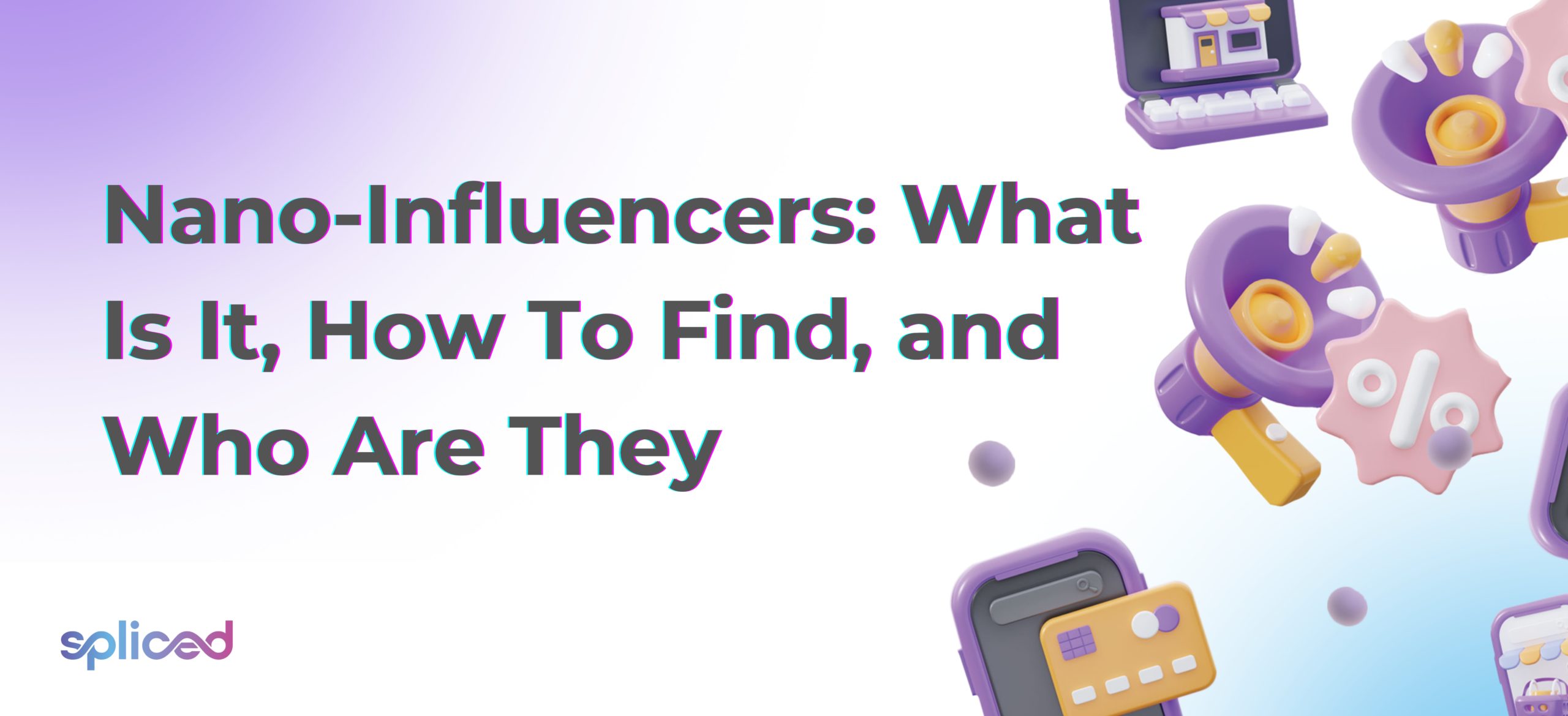Nano-influencers have a modest yet profoundly engaged social media following. Nano-influence has a specific niche or community, typically reaching 1,000 to 10,000 followers. Nano-influencers stand out from macro- and mega-influencers because of their ability to create personalized content that speaks directly to their audience. The source of their impact is not in the number of followers but in their genuine knowledge and sincere connections.
Nano-influencers significantly shape trends, preferences, and purchase decisions within specialized domains. The significance of these influencers lies in their capacity to cultivate deep connections with their followers, similar to those of trusted advisors or companions. Nano-Influencers serve as a vital link connecting brands and consumers in today’s era, where authenticity holds significant importance. They offer a reliable and genuine platform for conveying brand messages.
Nano-influencers have the ability to have a major impact by generating customized content based on their real-life experiences and knowledge. Nano-Influencers share relatable experiences, provide advice, and take part in significant debates. Brands capitalize on such authenticity by collaborating with Nano-Influencers on marketing campaigns. Brands create collaborations with influencers that specialize in their respective professions to reach a passionate and receptive audience. It creates an environment in which promotional content is seen as a trustworthy recommendation.
Engaging with Nano-Influencers has several benefits. Brands reach highly engaged consumers with genuine specialized interests, increasing engagement and conversion rates. Nano-influencers are cheaper than larger influencers, appealing to firms with limited budgets. Their sincerity makes their content feel more like important insights than ads. Nano-Influencer collaboration has some drawbacks as well. Their reach is limited compared to macro or mega influencers because of their smaller following. Monitoring several Nano-Influencer relationships for a campaign takes time. Finding the appropriate balance between honesty and brand alignment is difficult.
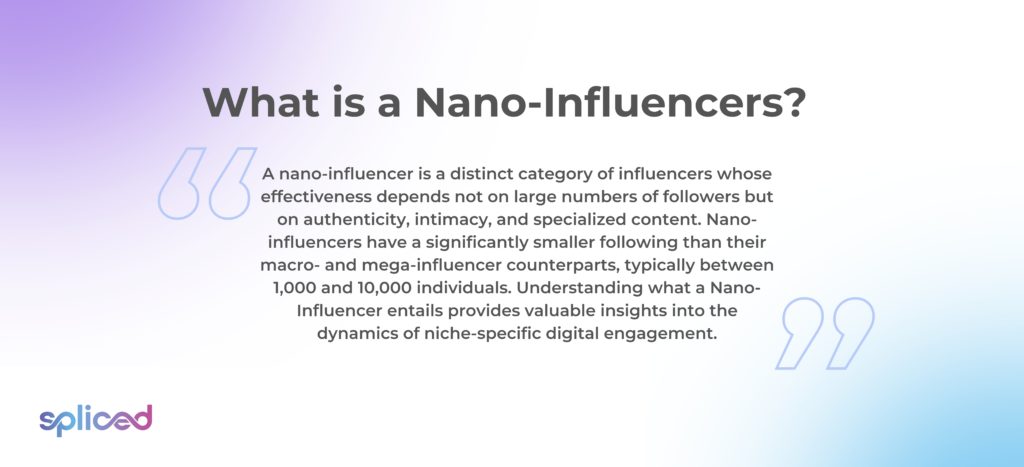
What is a Nano-Influencers?
A nano-influencer is a distinct category of influencers whose effectiveness depends not on large numbers of followers but on authenticity, intimacy, and specialized content. Nano-influencers have a significantly smaller following than their macro- and mega-influencer counterparts, typically between 1,000 and 10,000 individuals. Understanding what a Nano- Influencer entails provides valuable insights into the dynamics of niche-specific digital engagement. Their significance goes beyond quantitative metrics; it stems from their skill at cultivating genuine relationships.
Nano-influencers occupy a distinct tier within the influencer community, distinguished by their increased engagement rates and niche-specific orientation. Their content revolves around their daily lives, combining intimate stories, narratives, and insights within their specialized fields. The unfiltered approach resonates deeply with their audience, nurturing a sense of relatability and trust frequently rare among influencers with larger followings.
The majority of social media platforms are dominated by influencers in today’s digital age. An influencer is a person who has the ability to shape opinions, influence behaviors, and direct decisions. Theauthority is a result of their ability to attract the attention of their online followers, thereby facilitating the emergence of trends, directing preferences, and influencing purchasing decisions across various domains.
The most important thing about nano-influencers is that they have a unique ability to build real relationships with their audience. They are no longer just faraway digital entities. Nano-Influencers have become confidants, advisors, and even virtual friends for those who follow them. The personal connection is a huge plus for brands that want to promote their goods or services in specific niches. Nano-influencers have the power to change people’s buying choices by making suggestions that don’t have a clear commercial bias, like a trusted friend giving advice.

How do Nano-Influencers differ from other types of Influencers?
Nano-Influencers differentiate themselves from other influencers by having a smaller but more engaged following. Nano-influencers generally have a follower count ranging from 1,000 to 10,000, which sets them apart from mega, macro, and micro-influencers with significantly larger audiences. Their highly focused and specialized niche, which encourages genuine connections with their followers, sets them apart.
Nano-Influencers have a higher rate of engagement and more genuine interactions as a result of their content’s close resonance with their audience’s interests. Nano-influencers’ impact frequently stems from their ability to establish trust and credibility. The extent of their influence is relatively restricted compared to larger influencers, which makes them particularly appealing to brands looking for targeted promotion and genuine engagement.
Nano-Influencers are more relatable and unique. They have a more personal online presence, as their content tends to reflect their daily lives and experiences. Nano-Influencers get to respond to comments and messages, enhancing the sense of community and accessibility. Nano-influencers charge less for collaborations than other types of influencers, making them affordable for brands with smaller budgets. Their content is distinctive for its originality and creativity, frequently showcasing niche-specific insights that cater to their devoted audience.
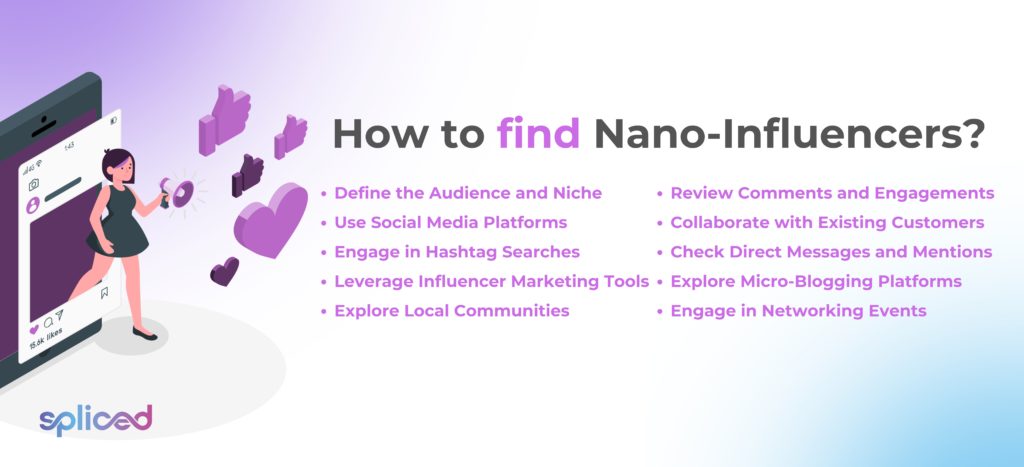
How to find Nano-Influencers?
Listed below are steps on how to find Nano-Influencers.
- Define the Audience and Niche: Clearly outline one’s target audience and the specific niche or industry relevant to the brand. The step helps one identify nano-influencers who cater to one’s ideal customer base.
- Use Social Media Platforms: Utilize social media networks such as Instagram, Twitter, and TikTok, along with Facebook, to search for hashtags, keywords, and subjects that are associated with the brand. Keep an eye out for posts with few likes and comments that pique one’s interest.
- Engage in Hashtag Searches: Search for hashtags that are relevant to one’s industry or campaign. Look for posts from users with smaller follower count who create content related to their niche.
- Leverage Influencer Marketing Tools: Several influencer marketing platforms and tools help one identify nano-influencers within specific niches. These tools often provide insights into engagement rates, audience demographics, and content style.
- Explore Local Communities: Find local community groups, forums, or platforms where individuals share content related to their niche. Local nano-influencers have a strong presence within these communities.
- Review Comments and Engagements: Check the comments section of posts from larger influencers within the niche. Individuals leaving thoughtful comments on these posts are nano-influencers most of the time.
- Collaborate with Existing Customers: Consider reaching out to existing customers who are active on social media and have a smaller following. They are likely to be interested in promoting a brand if they are genuinely passionate.
- Check Direct Messages and Mentions: Some nano-influencers have reached out to the brand directly or mentioned them in their posts. Check direct messages and brand mentions for potential collaboration opportunities.
- Explore Micro-Blogging Platforms: Platforms, such as Medium, Tumblr, and niche-specific forums often have individuals sharing detailed content within specific areas of interest. These individuals are potential nano-influencers.
- Engage in Networking Events: Attend local events, meetups, and networking gatherings related to the industry. There is a high chance of meeting active individuals in the same niche with a smaller online following.
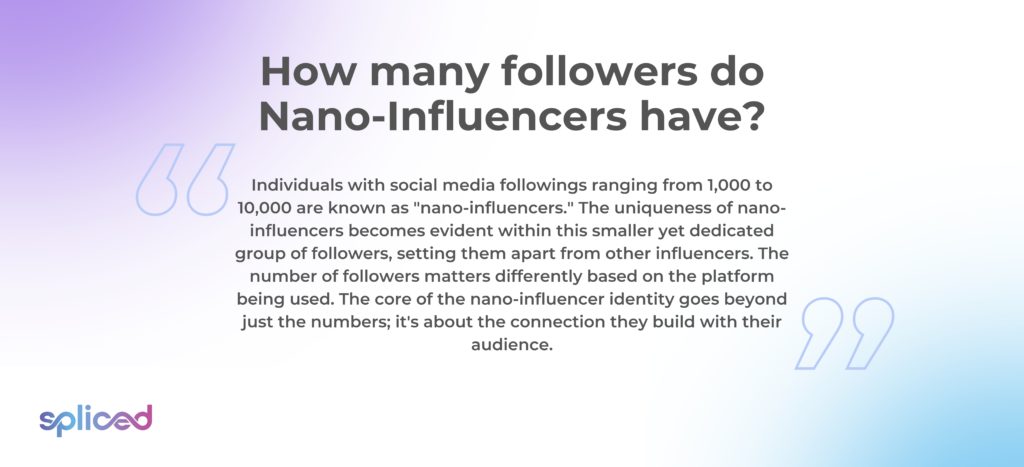
How many followers do Nano-Influencers have?
Individuals with social media followings ranging from 1,000 to 10,000 are known as “nano-influencers.” The uniqueness of nano-influencers becomes evident within this smaller yet dedicated group of followers, setting them apart from other influencers. The number of followers matters differently based on the platform being used. The core of the nano-influencer identity goes beyond just the numbers; it’s about the connection they build with their audience.
What sets these influencers apart is the level of engagement they maintain with their followers. Nano-influencers create a more personal and meaningful exchange, resulting in deeper and more resonant interactions because they have a relatively smaller group of followers. Their followers often include friends, family, or people who share specific interests, leading to a community that actively participates and enthusiastically embraces the content they share.
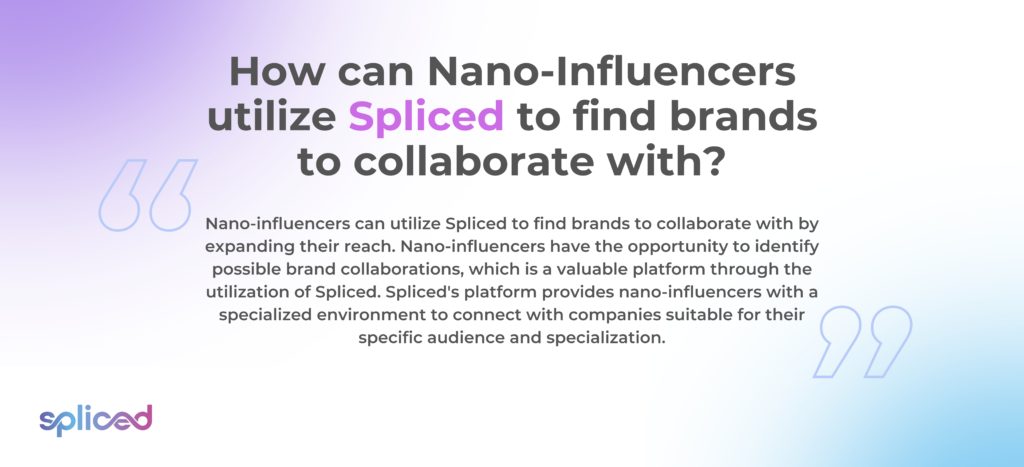
How can Nano-Influencers utilize Spliced to find brands to collaborate with?
Nano-influencers can utilize Spliced to find brands to collaborate with by expanding their reach.
Nano-influencers have the opportunity to identify possible brand collaborations, which is a valuable platform through the utilization of Spliced. Spliced’s platform provides nano-influencers with a specialized environment to connect with companies suitable for their specific audience and specialization. Nano-influencers have the ability to exhibit their content, engagement analytics, and audience demographics by building a profile on the platform Spliced by themselves. Brands looking for genuine and specialized representation look through these profiles to find nano-influencers whose beliefs and content are congruent with their products or services.
Spliced allows nano-influencers to express interest in cooperating with particular businesses to support a more streamlined approach. It makes it possible for brands to discover and engage with nano-influencers that genuinely connect with target audiences. Nano-influencers receive exposure, and brands gain access to a more personal and engaged audience through real advocates of their products or services in such a mutually beneficial relationship. Such a relationship generates true collaborations that are beneficial to both sides.
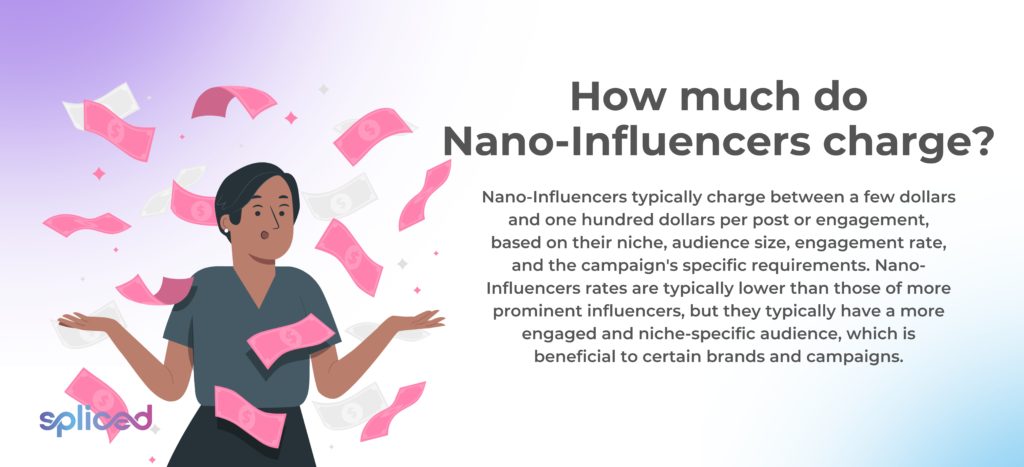
How much do Nano-Influencers charge?
Nano-Influencers typically charge between a few dollars and one hundred dollars per post or engagement, based on their niche, audience size, engagement rate, and the campaign’s specific requirements. Nano-Influencers rates are typically lower than those of more prominent influencers, but they typically have a more engaged and niche-specific audience, which is beneficial to certain brands and campaigns.
For instance, Nano-influencers on TikTok usually charge $800 per post. They charge $10 to $100 per post on Instagram. Instagram’s standard rate is $1000 per 100,000 followers. Facebook influencer postings cost an average of $25 per post per 1,000 followers. That equates to $250 for every 10,000 followers. The average cost of uploading a video to YouTube is $20 for every 1,000 subscribers.
Snapchat Nano-Influencers charge $10 per post for every 1,000 followers. Twitter’s influencer rates average $2 per post for every 1,000 followers. Twitter has the lowest influencer marketing fees and is one of the most affordable. Influencers charge approximately $60 per post per 1,000 unique visitors if brands want them to drive traffic to their websites through their blogs.
The monthly earnings of nano-influencers fluctuate substantially based on a variety of factors. Nano-influencers earn an average of between a few hundred and a few thousand dollars per month through sponsored posts, collaborations, and other promotional activities. Nano-Influencers’ monthly income differs based on the number of campaigns they participate in, their engagement rates, and the niches they specialize in.
These earnings include monetary compensation and non-monetary benefits, such as complimentary goods and services. Negotiating with each nano-influencer individually based on brand-specific requirements and budget is essential, as pricing varies significantly.
How are Nano-Influencers used in Influencer Marketing?
Nano-Influencers are utilized strategically in influencer marketing campaigns to capitalize on their unique advantages. Brands are aware that their smaller but highly engaged, following embody trustworthiness and authenticity. It allows nano-influencers to act as relatable promoters, integrating products or services into their content without being overtly promotional.
Nano-influencers are frequently selected based on their compatibility with a brand’s niche or values, thereby assuring a more targeted audience. Their endorsements are perceived as recommendations from a friend, given their personal relationships with their followers, thus boosting the persuasiveness of the marketing message. Emerging brands and businesses focus on Nano-influencer marketing to tap into specific niche audiences and build genuine connections.
Nano-Influencer’s comparatively lower fees in comparison to more prominent influencers make them an appealing option for brands with limited budgets. Nano-influencers promote the creation of an authentic and sincere connection between the brand and its target audience, thereby leading to enhanced engagement and more substantial outcomes in influencer marketing.
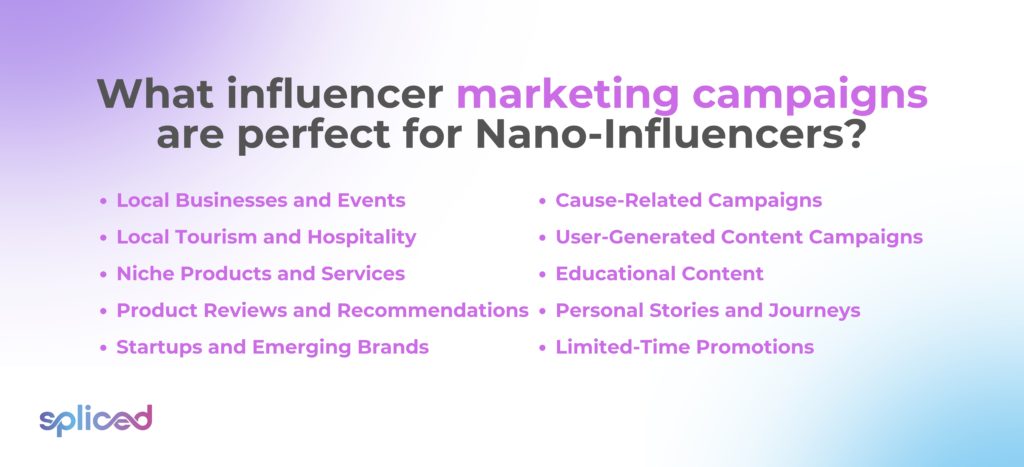
What influencer marketing campaigns are perfect for Nano-Influencers?
Listed below are influencer marketing campaigns perfect for Nano-Influencers.
- Local Businesses and Events: Nano-influencers with a local following effectively promote local businesses, events, and initiatives. Their smaller reach generates buzz within a specific community and drives local engagement.
- Local Tourism and Hospitality: Nano-influencers showcase local attractions, restaurants, and hotels, making them excellent for promoting tourism and hospitality-related campaigns at a local level.
- Niche Products and Services: Nano-influencers who are experts or enthusiasts in a particular niche authentically promote niche products or services. Their targeted audience is more likely to be genuinely interested in the offering.
- Product Reviews and Recommendations: Nano-influencers provide honest and relatable product reviews and recommendations. Their authenticity resonates with their followers, making their endorsements more trustworthy.
- Startups and Emerging Brands: Nano-influencers help new and emerging brands gain initial visibility and build a loyal customer base. Their personal touch aligns well with the brand-building phase.
- Cause-Related Campaigns: Nano-influencers effectively raise awareness for charitable causes, social issues, or community initiatives. Their passionate engagement helps spark meaningful conversations around important topics.
- User-Generated Content Campaigns: Brands encourage nano-influencers to create user-generated content related to a specific campaign theme or challenge. The approach leverages their creativity and connection with their audience.
- Educational Content: Nano-influencers with expertise in a certain field create educational content, tutorials, or how-to guides that resonate with their audience’s interests.
- Personal Stories and Journeys: Nano-influencers share personal stories, experiences, and journeys that connect with their followers on a deeper level, making them ideal for brand storytelling campaigns.
- Limited-Time Promotions: Nano-influencers create urgency for limited-time promotions or flash sales, driving immediate action from their engaged followers. Companies often leverage influencer marketing campaigns to expand their brand reach and connect with their target audience through promotions.

Do you pay Nano-Influencers before or after?
The terms of payment for nano-influencers vary depending on the agreement between the brand and the influencer. Establishing payment terms is customary before the influencer begins promotional activities. Influencer payments are any type of payment paid to a freelance marketer with a targeted social media audience in exchange for content development and/or promotion. Expect to pay between $10 and $1,000 per post, depending on the influencer’s audience size, the social media platform, and the marketing campaign.
Two standard payment methods for working with nano-influencers are advance payment and payment based on performance. Many brands pay nano-influencers upfront before they begin advertising the product. The process guarantees that the influencer is compensated for their time and content creation. The upfront payment consists of a fixed fee, a negotiated rate, or a combination of monetary compensation and complimentary goods or services.
Brands select performance-based payment, in which nano-influencers are compensated based on specific metrics, such as the number of likes, comments, shares, or clicks their posts generate in some instances. Such a strategy aligns the compensation of influencers with the actual engagement their content generates.
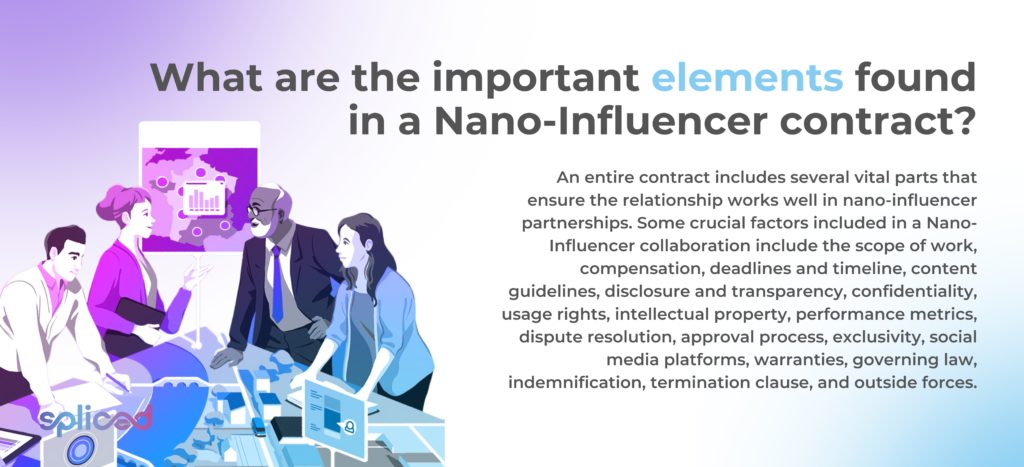
What are the important elements found in a Nano-Influencer contract?
An entire contract includes several vital parts that ensure the relationship works well in nano-influencer partnerships. Some crucial factors included in a Nano-Influencer collaboration include the scope of work, compensation, deadlines and timeline, content guidelines, disclosure and transparency, confidentiality, usage rights, intellectual property, performance metrics, dispute resolution, approval process, exclusivity, social media platforms, warranties, governing law, indemnification, termination clause, and outside forces. The scope of work must outline what the nano-influencer is expected to deliver, such as a certain number of posts, videos, or stories, as well as the style and platform.
The schedule must indicate the length of the campaign and the essential points for creating and sharing content, which helps ensure everything goes smoothly. Compensation terms are fundamental because they specify exactly how the nano-influencer is paid: a set fee, free products, or a combination. Detailed content guidelines handle the complexities of creating content by explaining the brand’s needs in terms of quality, tone, and style to keep the brand consistent.
The contract goes into great detail about usage rights and how the brand makes use of the influencer’s creations. It includes everything from reposting it on the brand’s platforms to making changes to the content or even using it in a marketing effort. Transparency is one of the most critical parts of the relationship between an influencer and a brand. The disclosure and transparency part of the relationship shows how vital transparency is by stating that the influencer has an obligation to disclose the collaborative nature of the engagement in accordance with the law, which builds authenticity and trust with the audience.
Confidentiality provisions protect important campaign information from unauthorized disclosure. In contracts where the brand needs undivided attention, exclusive commitments prohibit the influencer from supporting other products during the campaign. The contract outlines a dispute resolution system to prevent disagreements.
The termination clause of a strong contract details the circumstances under which any party prematurely terminates the agreement and the related consequences. Intellectual property rights are defined in the campaign, including content ownership and usage rights. Performance measures, including engagement rates, click-through rates, and performance goals, define the campaign’s success.
The indemnification clause protects both parties from any claims arising from the influencer’s content or activities throughout the engagement, guaranteeing a balanced and secure alliance. A nano-influencer contract combines these features to foster collaboration, brand alignment, interest protection, and mutual goal achievement.
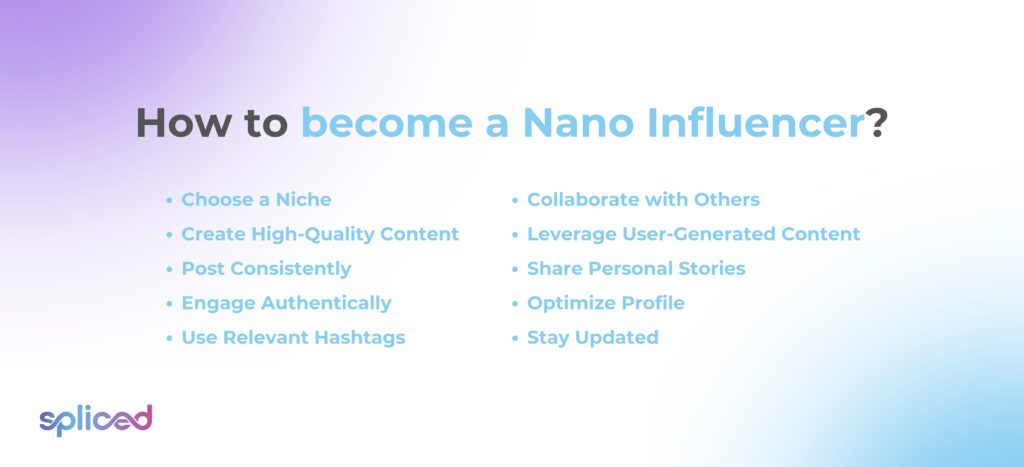
How to become a Nano Influencer?
Listed below are steps on how to become a Nano-Influencer.
- Choose a Niche. Choose a niche in which one is genuinely passionate and knowledgeable. A focused niche allows one to connect with a more specific audience.
- Create High-Quality Content. Develop content that demonstrates expertise and resonates with an audience. Ensure that the content is visually alluring and informative.
- Post Consistently. Regularly update the chosen platform(s) with fresh content. Consistency helps build anticipation among followers and keeps them engaged.
- Engage Authentically. Genuinely engage with the audience. Respond to comments and messages and participate in niche-related discussions. Authentic interactions contribute to the development of a sense of community.
- Use Relevant Hashtags. Incorporate relevant and trending hashtags to increase the visibility of the content. It enables users interested in their niche to find their posts more easily.
- Collaborate with Others. Collaborate with fellow nano-influencers or creators in one’s niche. Cross-promotions introduce someone to a broader audience.
- Leverage User-Generated Content. Encourage viewers to develop niche-related content and share it on their platform. It gets people more interested in and involved in the community.
- Share Personal Stories. Share personal experiences and stories that are connected to one’s personal niche. It gives a business more personality and helps one connect with their audience better.
- Optimize Profile. A profile or bio must reflect someone’s niche, knowledge, and usefulness to followers. Use keywords that have to do with the related field.
- Stay Updated. Stay up to date on trends, news, and changes in the chosen industry. Sharing current information shows one’s knowledge and keeps them in the loop.
- Utilize Stories and Live Videos. Use features, such as Facebook Live, TikTok Live, or Instagram Stories to interact with the audience in real-time and establish a more personal connection.
- Provide Value. Concentrate on giving personal followers something of value. Do it through educational content, lessons, recommendations, or insights tailored to their specific interests.
- Connect to a Network. Attend niche-related events, webinars, and online groups. Networking allows one to connect with like-minded people and future followers.
- Be Patient. It takes time to build a genuine following. Patience is essential as one cultivates relationships and encourages community engagement.
- Monitor Analytics. Monitor analytics to determine which content resonates most with the audience, when they are most active, and what drives engagement.
- Maintain Authenticity. Authenticity is essential. Maintain one’s personality, values, and expertise to build a loyal and trustworthy audience.
- Adapt and Evolve. Maintain a willingness to modify content strategy based on feedback and shifting trends. Flexibility guarantees that the content remains relevant.
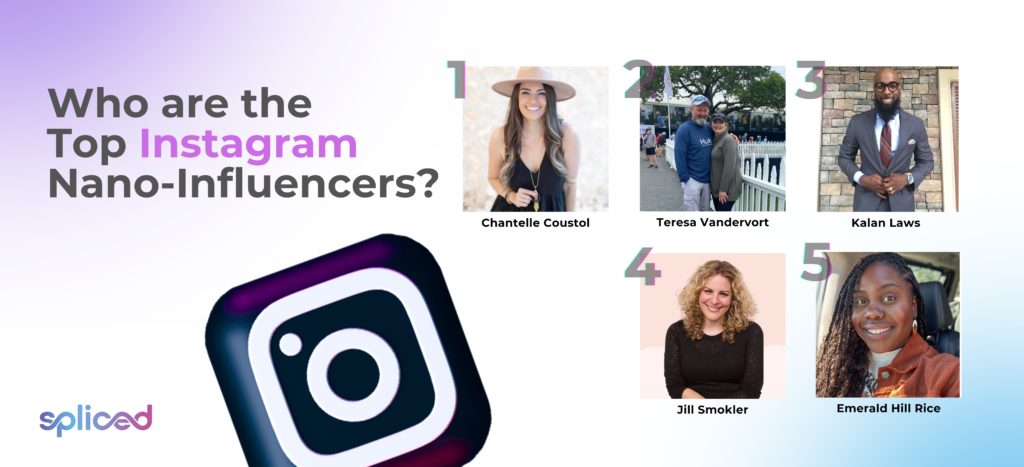
Who are the Top Instagram Nano-Influencers?
Listed below are the top Instagram Nano-Influencers.
- Chantelle Coustol (@thechann16): Chantelle is a Canadian parenting influencer, a wellness advocate, one of the top Nano-Influencers on Instagram, and a successful businesswoman. Chantelle currently resides in Texas. Chantelle has a health company called Petal, and Seeds. The mommy nano-influencer is a distributor of Young Living (YL) Essential Oils products and a Platinum member of Young Living (YL) Essential Oils. Most of Chantelle’s posts are family and health-related. Chantelle is a devoted mother to three precious daughters. Chantelle’s current followers on Instagram are more than 14,300.
- Teresa Vandervort (@happyplacecreations): Teresa is a registered nurse and businesswoman who loves to cook, make crafts, and plan the inside of homes. Teresa runs a home-based business called Topanga Scents, where the nano-influencer sells things like laundry soap, all-purpose cleaners, and toiletries. Teresa is one of the top emerging nano-influencers on Instagram in 2022. Teresa has more than 9,300 followers on Instagram. Most of Teresa’s posts are about DIY home decorations and organizations. Moms and other women relate to most of Teresa’s posts because of their authenticity.
- Kalan Laws (@senorguapo713): Houston, Texas-based model, athlete, and actor Kalan Laws is another influential figure in the world of fashion as well. Kalan represents Southern Gents and Hattitude as the brand ambassador for both companies. The Texas-based model finds great satisfaction working with businesses that exemplify sophistication and elegance. What makes Kalan’s post unique is that the style professor constantly gives tips on men’s fashion and proper dressing. Kalan constantly posts GRWM (Get Ready With Me) videos on Instagram showing how to style or dress for a certain season. Kalan has 10.7k followers on Instagram.
- Jill Smokler (@jillsmokler): Jill is a well-known entrepreneur, a leading nano influencer, an author of books that have been bestsellers in The New York Times, a motivational speaker, and a community builder. Jill’s motherhood website, Scary Mommy, is widely recognized as one of the most significant digital parenting platforms that offers parents access to content of the highest possible caliber. Forbes Magazine named Jill as one of the 10 most important people in parenting in 2017. Scary Mommy started in March 2008, and it has won many praise and awards since then. For example, Jill wrote a book called Confessions of a Scary Mommy that went on to become a New York Times bestseller in April 2012.
- Emerald Hill Rice (@emmyrice): Emerald, often known as Emmy, is a Youtuber from North Carolina, has a Bachelor of Social Work and Counseling degree, is licensed as a lactation educator, and advocates for having home births. Emmy is one of the top nano influencers on Instagram. Over 111,000 people are subscribed to Emmy’s YouTube channel, The Rice Channel. Emmy is among the top Instagram Nano-Influencers to watch out for.
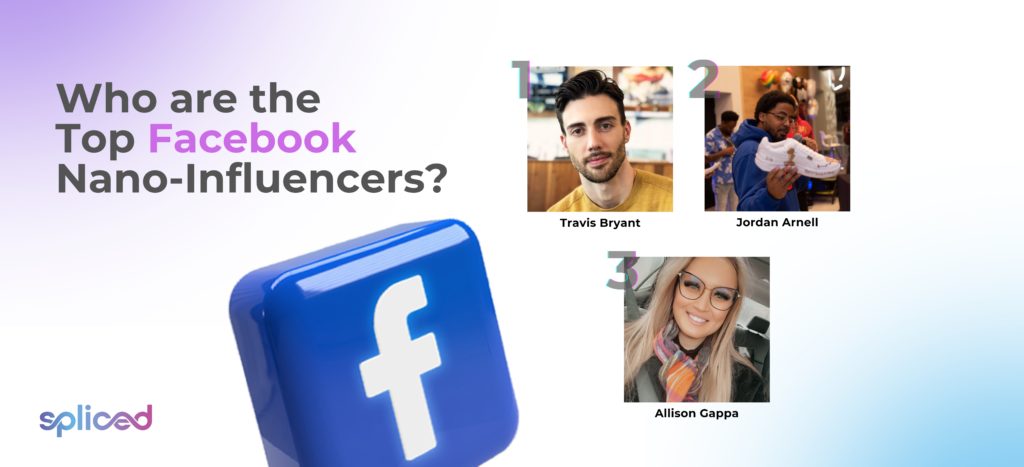
Who are the Top Facebook Nano-Influencers?
Listed below are the top Facebook Nano-Influencers.
- Travis Bryant: The Nano-influencer was a former male fashion model. Travis’ brand focuses on health, beauty, fitness, and lifestyle. Travis usual posts include tutorials, reviews, skits, and other happy videos. Travis is based in California, USA. Travis Bryant is a Nan0-Influencer with 10k followers on Facebook. Travis Bryant’s asking price between collaborations is $115.10.
- Jordan Arnell: Jordan Arnell is an artist and a Nano-Influencer from Ohio, USA. The talented artist has created artwork for the NBA, including for star players Lebron James, Kyrie Irving, and Rick Ross. Jordan’s topics are primarily about design, artwork, lifestyle, advertising, and films. Jordan Arnell’s current followers on Facebook are 5629. Arnell’s asking price starts at $142.
- Allison Gappa: Allison has 5819 followers on Facebook. Allison was a former sports broadcaster at Fox Sports. Currently a Commercial Real estate marketing director at KEW Realty Corporation. Allison Gappa’s asking price starts at $86.80. Allison Gappa is among the top Facebook Nano-Influencers.
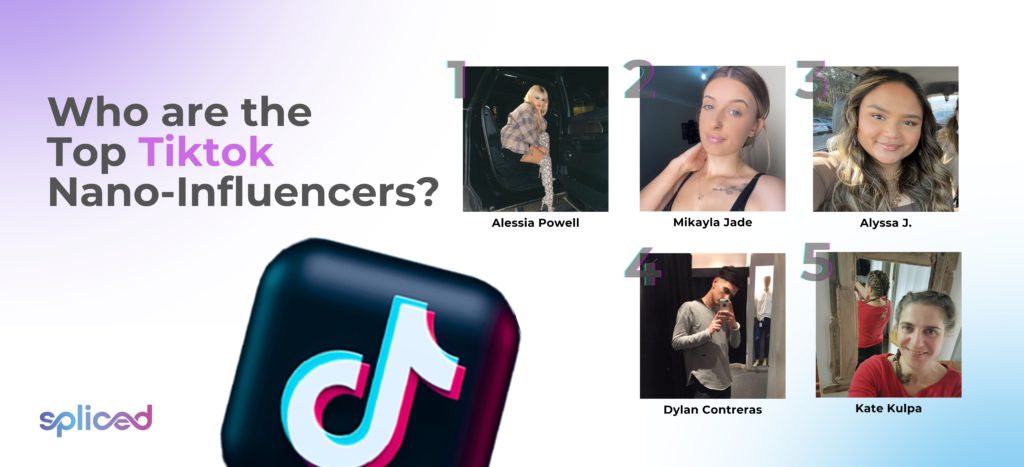
Who are the Top TikTok Nano-Influencers?
Listed below are the top TikTok Nano-Influencers.
- Alessia Powell: Alessia is a nano-influencer on TikTok with 4665 followers. Some of Alessia’s posts include prepping diet meals, motivational quotes, travel, and fitness. Alessia’s fun TikTok videos include the influencer’s boyfriend. They do silly stuff and travel on adventures together.
- Mikayla Jade: Mikayla is a nano-influencer on TikTok who loves to post about beauty, fashion, travel, and good vibes. Mikayla has 9046 followers as of the moment. Most of MIkayla’s content on TikTok shows the influencer’s love for traveling and living life to the fullest. Mikayla’s other posts are product recommendations, such as perfumes, makeup, and clothes.
- Alyssa J.: Alyssa’s usual content is handbag unboxing and product recommendations. Alyssa even makes videos suggesting products, such as bags under $500. The influencer is good at making reviews about different products and explaining their benefits and prices carefully. Alyssa currently has 10k followers on TikTok.
- Dylan Contreras: Dylan is a nano-influencer and a photographer on TikTok. Most of Dylan’s content includes product reviews and tips and tricks on photography. The nano-influencer shares photo shoots behind the scenes and some apps that help edit photos. Dylan’s followers on TikTok are 2332.
- Kate Kulpa Kate is a Chicago-based brand strategist and a nano-influencer. Kate’s content primarily includes beauty, fashion, travel, marketing, and dating. Most of the influencer’s favorites in beauty, fashion, wellness, home, fitness, and pet finds are on Kate’s Amazon page. Kate has 3397 followers and is one of the emerging top TikTok Nnao-Influencers.
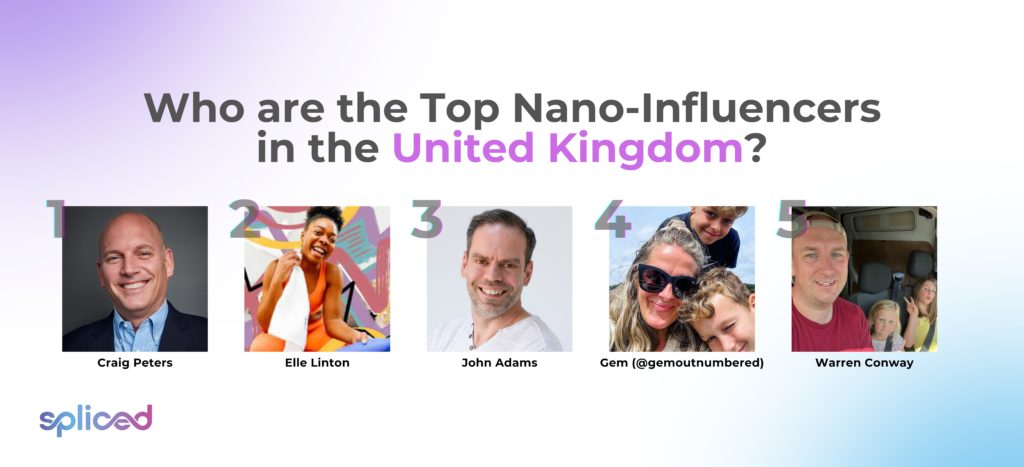
Who are the Top Nano-Influencers in the United Kingdom?
Listed below are the top Nano-Influencers in the United Kingdom.
- Craig Peters: Craig Peters is known as “The Burpee Guy.” Craig has been working with Reebok in the UK and the US for the past three years, despite having a maximum of 1000 followers on Instagram. Craig set out a personal goal in 2016 to raise more than $67,000 a year for a children’s charity close to the influencer’s heart. The company called out to Craig during the challenge on the same day as Reebok’s World Burpee Day. Craig only had 230 followers on the website at the time. Reebok gave money to Craig’s JustGiving page, gave the influencer exercise gear, and spread the word about Craig’s efforts on social media.
- Elle Linton: Elle Linton is a top Nano-Inlfuencer and a Liv Cycling UK Ambassador. Elle is a personal trainer and a running and cycling coach. Elle Linton runs a blog called keep it simpElle. Elle is a top Nano-influence because the personal trainer advocates for nutrition, movement, mindfulness, self-care, rest, and connection. Elle has 7,947 followers on Instagram. The fitness fanatic collaborates with Adidas Running as well as a small niche brand.
- John Adams (@dadbloguk): John Adams, one of Instagram’s top nano influencers, is a stay-at-home parent from the South East of England who has become an award-winning blogger and social media influencer. John’s site, Dadbloguk, is one of the few well-known UK-based dad blogs where the influencer writes about various parenting, family, and lifestyle topics. John is an avid photographer, a LinkedIn Changemaker, a media commentator, and a regular contributor to other blogs and newspapers aside from blogging. John’s Instagram account has nearly 7K followers as of 2022.
- Gem (@gemoutnumbered): Gem lives in Devon, United Kingdom. Gem is a loving wife and mother of two. Gem works as a pediatric nurse, writes a blog for parents, is a top nano influencer on Instagram, and advocates for better sleep for children. Gem co-created and now directs a program called Calm and Bright Sleep Support to help families all across the world get a good night’s rest. Princesshay Exeter is a prominent shopping and dining destination in the UK, and Gem is currently a brand ambassador for the establishment.
- Warren Conway (@warrenjconway): Warren is a father, an online influencer, and a business entrepreneur born and raised in Somerset, United Kingdom. Warren’s company, Clan 5 Independent, is a one-of-a-kind independent retailer and distributor of collectible trainer sneakers. The Conway Clan is the name of a YouTube channel that Warren and wife founded together. The couple posts comedic vlogs about their daily lives as a family and their travels.
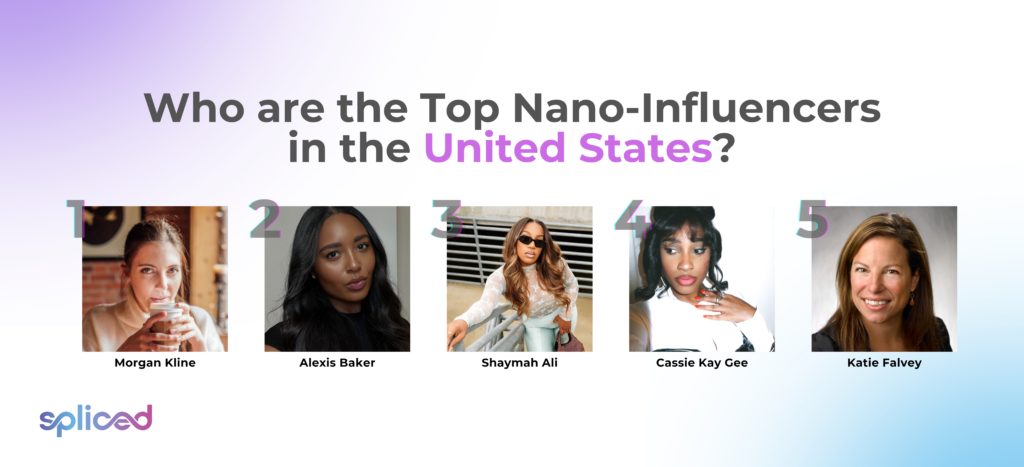
Who are the Top Nano-Influencers in the United States?
Listed below are the top Nano-Influencers in the United States.
- Morgan Kline (@morgantimm): Morgan is an influencer, blogger, and writer. Morgan has about 9K Instagram followers but over 150K TikTok followers. Morgan usually posts photographs of personal pets on Instagram, DIY projects, and baby name recommendations on the influencer’s other social media pages.
- Alexis Baker: Alexis Baker is a beauty influencer recognized in the New York Times for having crafted Instagram content as a Nano-Influencer. Alexis was scouted by an influencer marketing agency after several posts praising products, such as Suave Professionals Rose Oil Infusion shampoo, Clinique Beyond Perfecting foundation and concealer, and Loco Coffee. Alexis now works with well-known skincare, beauty, and clothing brands. Alexis has a YouTube channel dedicated to her cosmetics and skincare procedures.
- Shaymah Ali: A digital marketer and one of Instagram’s top nano influencers, Dallasite Shaymah is a lifestyle influencer known for promoting reasonably priced clothing. Urban Skin Rx, Quay Australia, and The Crunch Cup are just a handful of the companies Shaymal has collaborated with. Shaymah discusses a personal skincare routine, offers advice on how to improve one’s appearance, and discusses other aspects of life on YouTube.
- Cassie Kay Gee: Cassie works as a blogger and social media influencer in beauty, fashion, and lifestyle, aside from being a nurse. Cassie is now a brand ambassador for several companies that produce medical uniforms and scrubs, such as Uniform Advantage. Cassie has over 12,000 subscribers on YouTube. Cassie updates regularly despite having a hectic schedule.
- Katie Falvey: Katie is a blogger, an influencer, and an upcoming law school graduate from Chicago. Katie has worked with numerous companies for compensation, including Wholesome Food, MaryRuth Organics, Ommie Snacks, Yeouth Skin Care, and others. Katie keeps a blog discussing the food products, health and wellness items, and travel destinations that she finds most enjoyable.
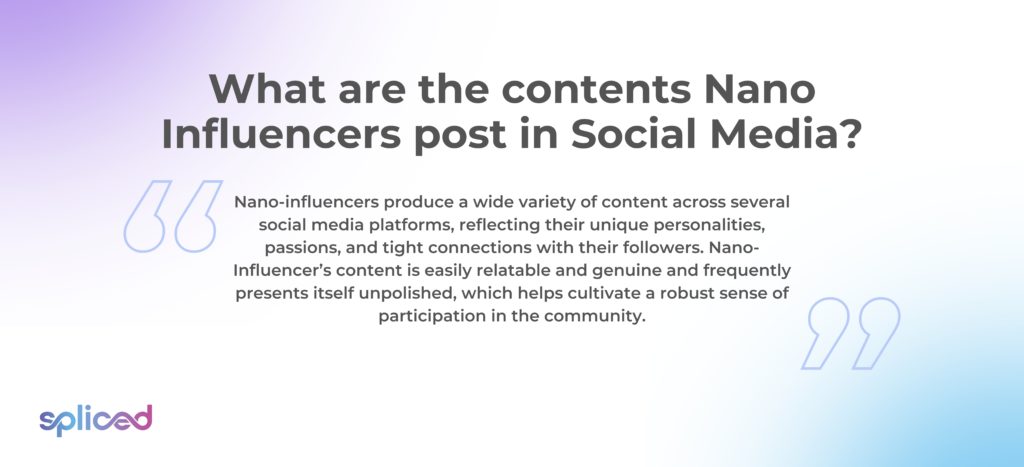
What are the contents Nano Influencers post in Social Media?
Nano-influencers produce a wide variety of content across several social media platforms, reflecting their unique personalities, passions, and tight connections with their followers. Nano-Influencer’s content is easily relatable and genuine and frequently presents itself unpolished, which helps cultivate a robust sense of participation in the community.
Marketing efforts for products, services, or ideas sometimes involve collaboration between brands and social media influencers to increase the reach and credibility of the promotion.
A social media influencer has amassed a sizable online following in a given field or niche and is widely respected as an expert. Expertise, authenticity, and interesting material give influencers the power to sway their followers’ thoughts, actions, and purchases.
Influencers in a given field produce and disseminate material (such as reviews, guides, and status updates) in an effort to sway the opinions and behaviors of their target audience. Micro-influencers (those with a very tiny following) and macro-influencers (those with a very large one) exist on social media, but the two extremes couldn’t be more different.
Followers engage with nano-influencers more intimately because they share personal experiences, stories, and everyday snippets of their lives with their audiences. They provide insights into their hobbies, interests, and daily routines so they build narratives that are relatable to their audience and resonate with them.
Nano-influencers are people who curate information aligned with their passion and operate within their chosen niche or area of competence. It takes the form of tutorials, recommendations, or product reviews in which the author expresses their genuine thoughts and experiences regarding a certain product or service. Inviting followers to join them on their path by sharing comparable struggles, victories, and learning experiences is a frequent topic.
Nano-influencers frequently engage in direct discussion with the people who follow them, facilitating dialogue by means of comments, direct messaging, and responses to surveys and queries. They seek advice, share recommendations, and ask for comments to foster a sense of community and involvement, which more prominent influencers need help accomplishing. Their content seems personal and inclusive because of the amount of engagement and discussion.
Nano-influencers work with sponsors to share sponsored articles that blend naturally with their content. Their approach to sponsored content is typically more authentic and less commercial, emphasizing their actual experiences with and ideas regarding the products and services offered by the company.
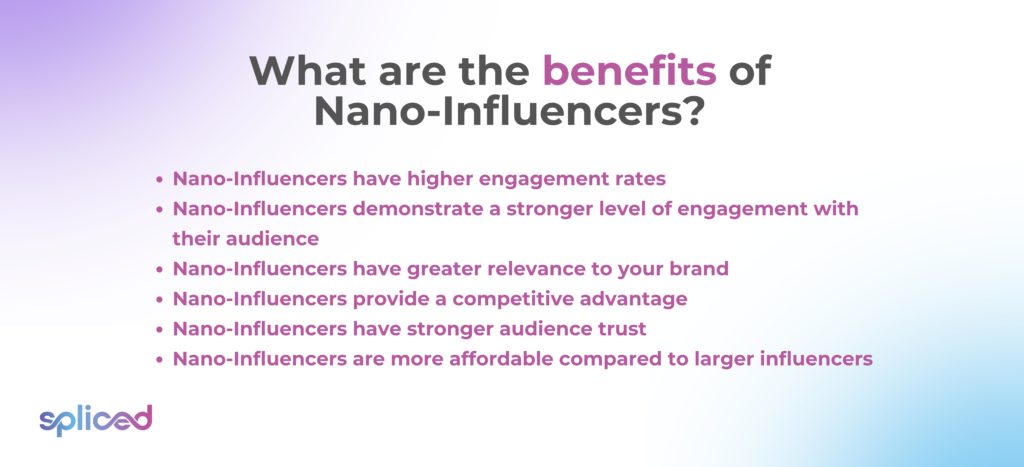
What are the benefits of Nano-Influencers?
The benefits of Nano-Influencers are listed below.
- Nano-Influencers have higher engagement rates: Nano-Influencers have a stronger relationship with their followers than influencers with enormous followings, such as celebrities and stars. The greater the number of followers, the lower the engagement rate.
- Nano-Influencers demonstrate a stronger level of engagement with their audience: Nano-influencers attain a more dedicated and attentive audience by concentrating their efforts on a distinct niche.
- Nano-Influencers have greater relevance to your brand: Nano-influencers typically engage individuals intrigued by a particular subject or theme due to their compact yet engaged follower base. The resonance with Nano-Influencers is elevated as their content carries a more personalized touch.
- Nano-Influencers provide a competitive advantage: Personalized interaction from micro-influencers strengthens bonds between brands and their customers on a deeper level than just the transactional. It helps in the development of a dedicated and enthusiastic fan base for them.
- Nano-Influencers have stronger audience trust: Nano-influencers garner the trust of their audience through effortless connections and relatable communication. Their adeptness at establishing relationships with followers directly results from the relatability inherent in their posts.
- Nano-Influencers are more affordable compared to larger influencers: Nano-Influencers have a smaller follower count, which naturally translates to lower demand for compensation.
1. Nano-influencers have higher engagement rates
Nano-influencers possess a distinctive quality that sets them apart from their peers: notably elevated interaction levels. Nano-influencers exhibit the noteworthy characteristic of garnering 8% of likes on unpaid Instagram posts, unlike other influencers, who experience declining engagement rates as their follower count expands. Public figures boasting follower counts ranging from 1,000 to 10,000 receive merely 4% of the likes. An additional study underscores such a trend, revealing that the rate of engagement among nano-influencers surpasses that of other influencer categories by twofold. It underscores the implication that when collaborating with influencers on sponsored content, brands expect a significant portion of their followers to take notice.
2. Nano-influencers demonstrate a stronger level of engagement with their audience
Nano-influencers have an uncanny ability to make stronger and deeper connections with their audience than influencers with bigger followings. The high level of engagement is because their material is personal and easy to relate to. Nano-influencers reach an audience that is more devoted and receptive, which results in interactions that aren’t just fleeting but rather crucial and continue for a considerable amount of time because of their focus on their niche. The increased engagement creates a sense of community and trust, where each piece of content gets more attention, interaction, and talk, pushing brands toward more impactful and authentic engagements.
3. Nano-influencers have greater relevance to your brand
Nano-influencers have a solid connection to a brand, more so than standard influencers. Their value comes from how well they fit the brand’s values, message, and market niche. Nano-influencers seamlessly combine someone’s brand into their content using their specialized knowledge. It creates a seamless story that feels natural and real. The alignment isn’t just on the surface, it goes deep into the core interests of their engaged fans, which has a bigger and longer-lasting effect. It makes it easy for nano-influencers to get across the essence of a brand and create an emotional link with their audience that hits home. So, the partnership is more than just a way to promote each other’s brands. It becomes a mutually beneficial relationship that spreads a brand’s message through a channel that knows and embraces its identity.
4. Nano-influencers provide a competitive advantage
Nano-influencers have a unique competitive edge. Nano-Influencers provide multidimensional value that strongly impacts modern marketing. Their sincerity, familiarity, and specific knowledge form a fascinating story, giving them a competitive edge. Nano-influencers’ customized engagement creates non-transactional connections. It helps them establish a loyal, engaged audience. Such dedication makes them great brand advocates who influence niche group buyers.
Nano-Influencers are growing faster than ever. Working with them helps brands and businesses stand out from the crowd. There’s a good chance that these influencers’ profiles won’t have any ads from their rivals. Nano-influencers are approachable and tell authentic stories that break through the noise and connect people beyond trends. The capability for meaningful engagement gives brands a strategic edge to create compelling stories that stick in a time when authenticity is crucial.
5. Nano-influencers have stronger audience trust
The audience trusts nano-influencers because they easily relate to them and their information. Thus, they consider public figures friends. Most importantly, they feel heard and understood when they contact them. People trust friends more than professionals when making money, time, or effort decisions. Nano-influencers produce more high-quality, audience-targeted material. Nano-Influencer’s commitment to being open makes the trust even stronger and makes sure that every contact is a real exchange of ideas and experiences. Such a higher level of trust from an audience isn’t just a one-time thing. It is the foundation of long-lasting relationships that puts nano-influencers in a situation where their influence is a powerful driver of brand success.
6. Nano-influencers are more affordable compared to larger influencers
One of the most significant advantages of collaborating with nano-influencers is that they demand a reasonable price for their services. Nano-Influencers receive fewer requests for partnerships from fitness brands than macro-influencers do since their inboxes are less complicated. Nano-Influencers are willing to spread the word about the company if it provides them with a free good or service. Other nano-influencers still prefer monetary recompense for their work, but their demand is low. Nano-influencers are the best choice for startups with limited budgets.
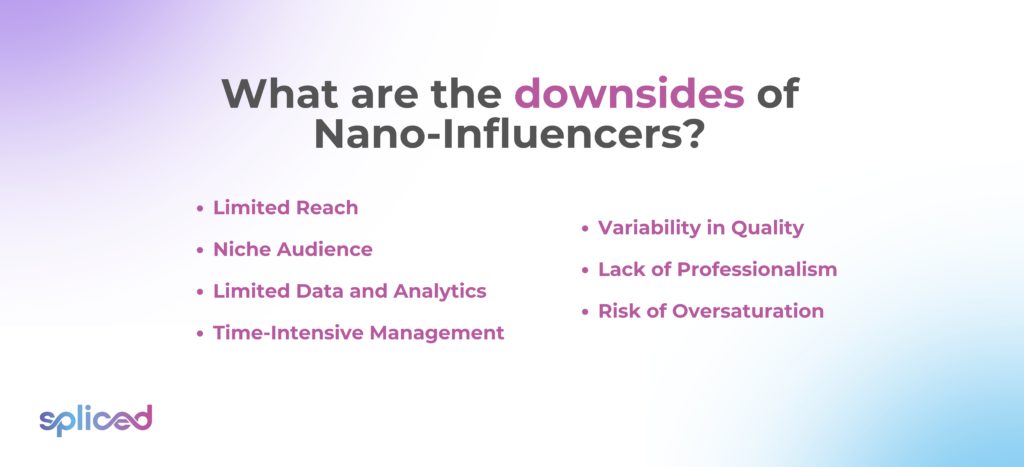
What are the downsides of Nano-Influencers?
Listed below are the downsides of Nano-Influencers.
- Limited Reach: One of the common downsides of nano-influencers is their limited reach. Campaigns with nano-influencers generate a different level of visibility or exposure than those with more prominent influencers due to their smaller follower counts. Brands seeking widespread awareness might find it challenging to achieve their goals solely through nano-influencers.
- Niche Audience: The niche audience is quite limiting while having a niche audience is advantageous for particular campaigns. Nano-influencers often have followers who share specific interests or belong to a particular community. It restricts the brand’s ability to target a broader audience or explore diverse markets.
- Limited Data and Analytics: Nano-influencers need access to robust analytics tools, making it challenging for brands to measure their campaigns’ effectiveness accurately. More data is needed to track key performance metrics and make informed decisions for future campaigns.
- Time-Intensive Management: Collaborating with a large number of nano-influencers is more time-consuming and logistically challenging than working with a smaller group of larger influencers. Brands need to establish clear communication channels, guidelines, and expectations for each influencer, which require more effort to coordinate effectively.
- Variability in Quality: The authenticity that makes nano-influencers appealing leads to variability in the quality of content. Since they are often not professional content creators, the quality of their posts, photography, and messaging may vary, potentially affecting the overall brand image.
- Lack of Professionalism: Some nano-influencers need more experience in professional collaborations, leading to potential challenges in terms of contractual agreements, deadlines, and deliverables. It results in miscommunications and hinders the smooth execution of a campaign.
- Risk of Oversaturation: There’s a risk of oversaturation, where the same product or message is repeatedly shared among a similar audience if a brand collaborates with numerous nano-influencers within the same niche. It leads to reduced novelty and engagement.
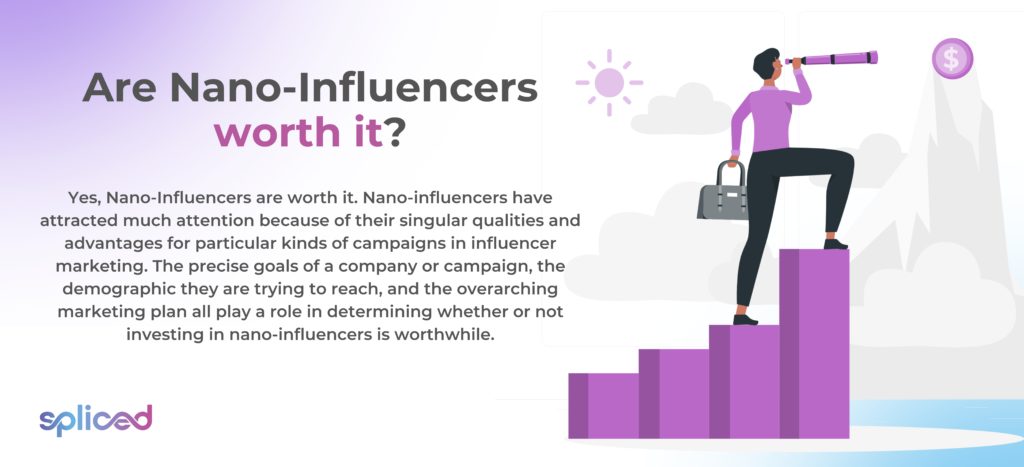
Are Nano-Influencers worth it?
Yes, Nano-Influencers are worth it. Nano-influencers have attracted much attention because of their singular qualities and advantages for particular kinds of campaigns in influencer marketing. The precise goals of a company or campaign, the demographic they are trying to reach, and the overarching marketing plan all play a role in determining whether or not investing in nano-influencers is worthwhile.
Working with nano-influencers is beneficial for several reasons, but one of the most important is that they are authentic and have a true relationship with the followers they have built up. Their suggestions and endorsements are typically seen as more trustworthy because of the personal nature of the content they post and the fact that most of their followers are friends, family members, or people who share the same specialized interests as them. A higher level of authenticity has the potential to translate into higher engagement rates and more meaningful conversations.
Nano-influencers typically have smaller price structures in comparison to larger influencers with a greater following. The cost-effectiveness might make them an appealing option for firms with restricted budgets, particularly for localized or niche marketing efforts where precision matters more than vast reach. Cost-effectiveness is sometimes more important than broad reach in these initiatives.
Consider the various constraints it presents when working with nano-influencers. There is a chance that campaigns including nano-influencers do not create the same degree of exposure as those involving macro-influencers because of the lesser reach of nano-influencers. Other types of influencers are more appropriate if the objective is to generate widespread awareness or communicate with many people.
The management of a campaign involving a high number of nano-influencers takes more time than the management of a campaign involving a smaller number of larger influencers. For their brands to deliver consistent messaging and remain aligned with their objectives, clear guidelines, communication channels, and strategic plans need to be established.

What is the difference between Nano-Influencers and Micro-Influencers?
Nano-influencers and micro-influencers are distinct categories within influencer marketing, distinguished by their number of followers and scope of influence. Nano-influencers typically have fewer followers, typically between a few hundred and a few thousand. They have a close and engaged relationship with their audience, as their followers are frequently acquaintances, family, or members of a niche community. The strength of nano-influencers is their authenticity and relatability, as their content is typically more personal and unfiltered. Despite their limited reach, brands collaborating with nano-influencers benefit from authentic endorsements and high engagement rates.
Micro-influencers have a slightly larger following, typically between a few thousand and 100,000 followers. Micro-influencers have a wider reach, making them more suitable for campaigns intended for a larger demographic. Micro-influencers specialize in particular niches, offering expertise and a devoted following. Brands that collaborate with micro-influencers delve into targeted audiences, authentic content, and meaningful interactions, which results in higher engagement rates in comparison to influencers with more significant followings.
The degree of personal connection, scope of influence, and potential reach distinguish nano-influencers from micro-influencers. Micro-influencers provide a balance between a focused niche and a slightly broader audience, tailored to the varying marketing objectives and target audiences of brands.
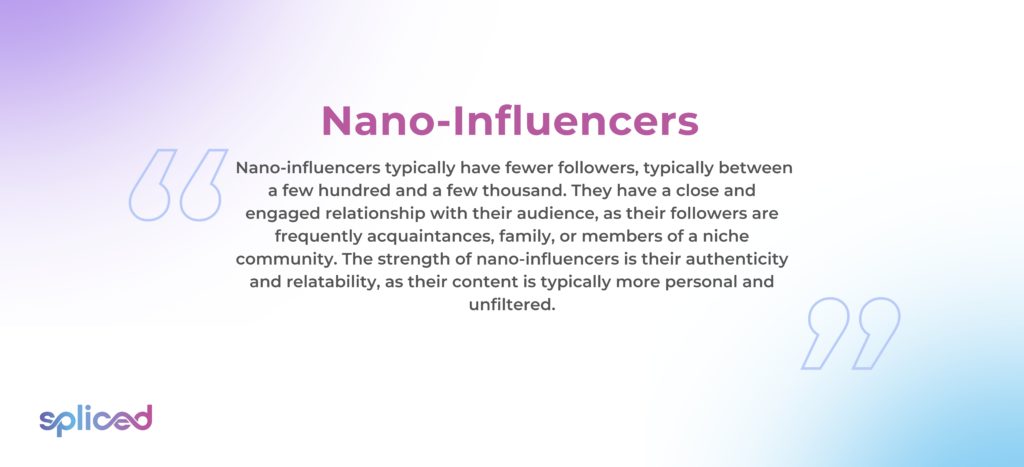
Listed below are the differences between Nano-influencers and Micro-influencers.
Nano-Influencers
- Smaller follower base, typically ranging from a few hundred to a few thousand.
- Often have a personal connection with followers, including friends, family, or niche community members.
- Highly authentic and relatable content, often unfiltered and personal.
- Engage in genuine conversations with their small but engaged audience.
- Well-suited for hyper-focused or niche campaigns.
- Limited reach compared to larger influencer categories.
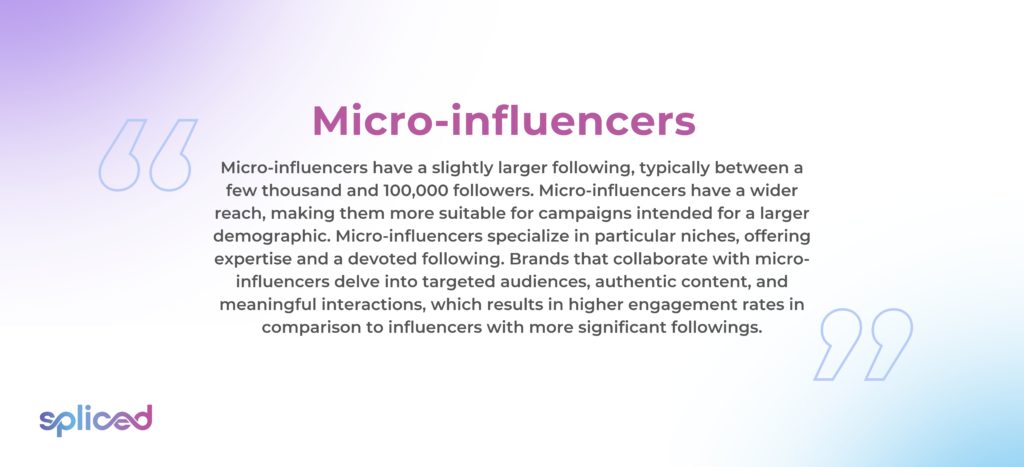
Micro-Influencers
- They have larger follower counts than nano-influencers, ranging from a few thousand to around 100,000.
- They maintain a personal connection with followers, but with a potentially broader reach.
- Content maintains authenticity while catering to specific niches of interest.
- High engagement rates due to their loyal and focused following.
- Caters to more diverse demographics without sacrificing authenticity.
- Suitable for targeted campaigns that aim to reach a broader yet engaged audience.
